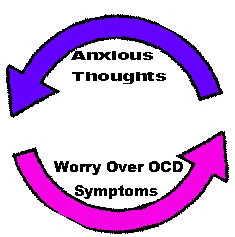 It’s common for children to get anxious about various things they face in their lives. A normal amount of worry can help motivate a child to complete a task, try his best in a performace, use caution in a dangerous situation, or show empathy for others. Worry is a natural human emotion. However, kids with obsessive-compulsive disorder (OCD)are ruled by anxiety and worry. Not only is the amount of anxiety they experience unnatural, but the fears themselves are often absurd. For example, a child with OCD might worry that her bus will crash if she doesn’t sit in precisely the same seat every ride. Or he might check the bottoms of his shoes dozens of times a day to see if he has stepped on a worm. This irrational worry is recurring and keeps the child constantly needing to reassure himself through the use of ritualistic behavior.
It’s common for children to get anxious about various things they face in their lives. A normal amount of worry can help motivate a child to complete a task, try his best in a performace, use caution in a dangerous situation, or show empathy for others. Worry is a natural human emotion. However, kids with obsessive-compulsive disorder (OCD)are ruled by anxiety and worry. Not only is the amount of anxiety they experience unnatural, but the fears themselves are often absurd. For example, a child with OCD might worry that her bus will crash if she doesn’t sit in precisely the same seat every ride. Or he might check the bottoms of his shoes dozens of times a day to see if he has stepped on a worm. This irrational worry is recurring and keeps the child constantly needing to reassure himself through the use of ritualistic behavior.
OBSESSIVE refers to the perpetual senseless thoughts that cause these kids anxiety.
COMPULSIVE refers to the overwhelming need to perform a ritual or task in order to ward off the anxiety. These behaviors might include things such as checking, counting, touching, hoarding, repeating words or movements, or doing things in a particular order. The rituals can range from simple to complex.
 The cycle of OCD can become an ongoing loop because eventually the child may start to worry about the anxieties themselves. In other words, a girl with OCD might wonder whether she forgot to put her name on her math paper at school. For a brief moment, she worries about it. Then she remembers that she did indeed put her name on the paper, but now starts to worry that her anxiety is going to come back. She becomes increasingly fearful that her OCD is going to ruin her whole day. So she delves into her rituals for comfort, which means that the OCD has literally fed and nurtured itself.
The cycle of OCD can become an ongoing loop because eventually the child may start to worry about the anxieties themselves. In other words, a girl with OCD might wonder whether she forgot to put her name on her math paper at school. For a brief moment, she worries about it. Then she remembers that she did indeed put her name on the paper, but now starts to worry that her anxiety is going to come back. She becomes increasingly fearful that her OCD is going to ruin her whole day. So she delves into her rituals for comfort, which means that the OCD has literally fed and nurtured itself.
How can I know for sure whether my child has OCD?
A psychological assessment is in order, and a visit with a child psychiatrist. OCD cannot be diagnosed unless your son or daughter has had symptoms for approximately a year, and they are significantly interfering with life at home and at school. Your son or daughter will have the classic symptoms of anxiety disorder, but will also have the odd fears and useless rituals.
What can be done?
Treatment includes special classroom accommodations, cognitive behavioral therapy, and medication. Selective serotonin reuptake inhibitors (SSRIs) such as Prozac, can sometimes be effective in helping to curb the obsessive thoughts and behaviors. Achieving a good result will require parents, doctors, and teachers to work together, making frequent assessments about how current therapies and medications are working. Adjustments should be made gradually when necessary. At home, parents should not treat the OCD symptoms as misbehavior, and children should never be punished for their rituals. Parents should make every effort to see the condition as a disorder of the brain and work diligently for an effective treatment strategy for their child. Children with obsessive-compulsive disorder (OCD) are eligible for special education, according to the Individuals with Disabilities Education Improvment Act of 2004 (IDEA).
Kristyn Crow is the author of this blog. Visit her website by clicking here. Some links on this blog may have been generated by outside sources are not necessarily endorsed by Kristyn Crow.

